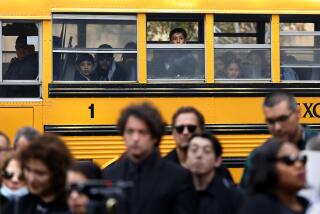Dumping on Girls: Now Thatâs Mean
SANTA CRUZ â When teenage girls spread ugly rumors to inflate their social status, ruin othersâ reputations and demean those who canât fight back, we call their conduct âbullyingâ and âmean.â So, what should we call todayâs wildly misleading campaign by authors, professionals and reporters that characterizes female teens as increasingly cruel âalpha girlsâ and gangsters who bully and put down their peers and others as never before?
âGirls are turning to violence more often and with terrifying intensity,â Associated Press claimed in a typical story. âWe can see girls falling prey to the same influences as boys,â said Phil Leaf, director of the Center for the Prevention of Youth Violence at Johns Hopkins University. âWeâre seeing the effects of children growing up in a world without adults.â The âsurge in girl violence,â including melees by suburban and inner-city girls, âreminds him of the William Golding novel âLord of the Flies,â â AP reported.
Step back, for a moment, from the books and media stories reporting that todayâs âqueen beesâ and âgirl gangsâ are more vicious and violent than their predecessors.
August marks the 35th anniversary of âhelter skelter,â in which the Manson familyâs privileged young women slaughtered a pregnant actress, her three wealthy companions, a teenage bystander and an older couple in their Los Angeles homes. They shot and beat and stabbed their victims 200 times, hanging and mutilating their bodies and scrawled âpiggiesâ on the walls with their blood.
The 25th anniversary of a 16-year-old girlâs sniper attack on a San Diego elementary school was in January. Two were killed and nine wounded.
Fifty years ago, an avalanche of books, films and Movietone newsreels warned of skyrocketing crime by the new âviolent onesâ -- gun-wielding âunderage girlsâ who âstart by stealing lipstick and end with a slaying.â
Adults of every era, it seems, pronounce girls meaner, more violent, more shocking. Though thereâs no long-term index of âmeanness,â the best measures -- the California Criminal Justice Statistics Center, FBI Uniform Crime reports, the Department of Justiceâs National Crime Victimization Survey and the Institute for Social Researchâs Monitoring the Future study -- show that girls today are no more -- and are usually less -- victimized, criminal and belligerent than they were a generation ago.
California teen girls, for example, are less likely to murder than any previous generation in the state since records were first kept decades ago. Girls today are arrested for homicide at half the rate of their mothersâ generation in the 1960s and â70s.
Because other violent crimes go in cycles, commentators can paint any picture they desire. But the latest 2002 figures show California girlsâ violent-crime arrest rates are no higher than 30 years ago. Monitoring the Future surveys find 1 in 10 girls today reports being in a serious fight at school or work, 1 in 7 in a fight involving a group, and 1 in 100 committing armed robbery -- about the same percentages the first survey found in 1975.
Actually, teenage-girl trends generally are encouraging. California crime and health statistics show them far less likely to die from suicide, homicide, drug abuse, guns and other violent causes than 30 to 40 years ago. They are also much less likely to be mothers, drop out of school, smoke, binge drink, drive drunk or be imprisoned than were baby boom girls in the 1960s and â70s.
Despite constant claims that todayâs girls are more troubled, unhappy and peer-tortured (central themes of psychologist/author Mary Pipherâs popular âReviving Opheliaâ and other commentaries), the latest Monitoring the Future survey finds high school girls happier: 71% say they are satisfied with themselves (fewer than 3% are âcompletely dissatisfiedâ), and 83% are happy with their peers. Girls today are more positive than their mothersâ generation in 1975 when 66% reported being happy with themselves.
While authorities trumpet that girlsâ proportion of juvenile violence arrests has climbed from 1 in 10 a decade ago to 1 in 4, they fail to mention the reason: that boysâ arrest rates have fallen more rapidly than girlsâ. From 1992-2002, violence-arrest rates of California girls declined by 20%, felony arrests fell 50% and murder arrests plummeted 70%; meanwhile, violent and felony arrests of boys dropped by 50% and murder arrest rates plunged 75%.
Furthermore, the federal Office of Juvenile Justice and Delinquency Prevention says that changes in the law requiring police to make arrests in family-violence incidents may explain why girlsâ and womenâs arrests rose (or didnât decline as fast) compared with boysâ and menâs.
What, then, accounts for rising alarms that girls are more menaced and menacing? When examined, the claims inevitably rely on adult commentatorsâ selected anecdotes, generalizations from troubled girls in treatment, sanitized memories of a tranquil past and omission of contradictory information. That is, the sort of assertions weâd call âprejudiceâ if used to describe any other group in society.
Creating a pleasing image of the older generation by displacing blame onto the younger one may be a more disturbing motivation behind todayâs âmean girlsâ furor. It isnât young women but baby boomers who show the most frightening trends.
Among adult women ages 30 to 59, felony arrest rates doubled and violence arrest rates soared by 220% in the last three decades. Today, a 40-year-old woman is much more likely to die from illegal drugs or be arrested for a serious crime than her high school-age daughter.
Why donât todayâs detractors of âmean girlsâ cite these alarming statistics to berate âmean middle-age womenâ? Because adults, like schoolgirls, observe the basic rules of bullying: Donât attack people like us or who can fight back.
In reality, adults who benefit financially and psychologically from spreading misleading, negative stereotypes demeaning politically powerless adolescents teach young people the value of bullying those who are weaker. The real warning of âLord of the Flies,â as Golding commented, is not children growing up without adults but mean kids emulating their meaner elders.
More to Read
Sign up for our Book Club newsletter
Get the latest news, events and more from the Los Angeles Times Book Club, and help us get L.A. reading and talking.
You may occasionally receive promotional content from the Los Angeles Times.







